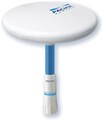Blogs
Groundplanes Explained
A groundplane is a flat, electrically reflective surface that some antenna models need to be sited on to work properly. The ideal groundplane is a quarter wavelength of the frequency required in every direction, so the higher the frequency, the smaller the groundplane.
The centre of a car roof provides an ideal groundplane, as it is flat, made of metal, large enough in all directions for most frequencies and unobstructed by other parts of the car. The centre of the boot offers similar advantages, but directional effects will be demostrable due to the obstruction of the antenna by the body of the car.
Antennas sited on the edge of a groundplane, such as the side of the roof or bonnet, will also produce directional effects as a result of not having an all-round groundplane.
Often the directional effects will be either not noticeable to the vehicle owner, or an acceptable consequence of not installing the antenna in the middle of the roof.
Mobile TV Antennas
Marine TV antennas have to be omnidirectional (able to receive TV signals from any direction) because a boat under way or swinging at anchor is constantly changing its bearing to the TV transmitter.
Because Omnidirectional antennas receive signals from any direction, weker reflected signals may show on the television as "ghosts". Ghosting is most likely to be noticed in marinas, where there are many reflected signals. Modern design minimises this effect, however the presence of "ghosts" in these locations is confirmation the antenna is doing what it should do - receiving signals from all directions.
Favourite anchorages and campsites are often in the fringe coverage areas where the TV signal is weak and variable. Amplified TV antennas will make the most of a weak TV signal. No antenna can produce a picture where there is no TV signal. In fringe TV coverage areas, shifting a few metres can make the difference between a good picture and no picture.
A top quality television is the smart choice for a boat, caravan, motor home or recreational vehicle. Some televisions are less sensitive than others and may not give a useable picture outside the main coverage areas.
Coaxial Cable
Coaxial cable is a key factor in antenna installation, and one that is often overlooked.
In every run, there is some loss of signal strength as the signal travels between the antenna and the radio. The longer the run of cable, the greater the loss will be.
At higher frequencies, such as cellular, the losses in the cable are much greater. Runs of up to 8m of RG-58A/U cable will produce acceptable performance at cellular frequencies. For longer cable runs, the RG-213 is strongly recommended.
Do not kink the cable, or fit tightly around obstructions on the vehicle. Kinks in the cable can lead tp splits in the jacket and shield, which will lead to a downgrade in performance over time.
If a join in the cable cannot be avoided, ensure high quality RF connectors are used and fitted correctly. Seal the joint with self-amalgamating tape or similar to ensure it is water tight.















